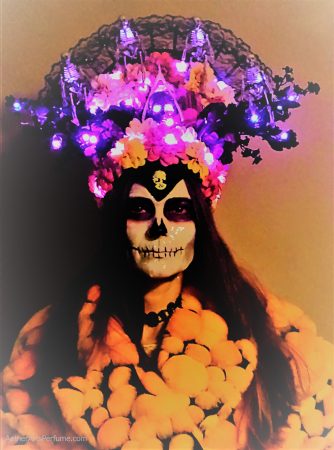
Amber Jobin of Aether Arts Perfume dressed for Dia de Muertos
“How tasty are the enchiladas from my small town of Rayón, though sometimes I get confused and I no longer know where they’re from.” ~ Enchiladas Calavera by Isabel Vasquez
Artisanal Art and Olfaction award-winning perfumer Amber Jobin and her fertile imagination always deliver something fascinating with each new endeavor. In timely fashion, she’s approached the upcoming Day of the Dead with her latest perfume. Aether Arts Perfume Dia de Muertos dips its fragrant toes into various pools with a celebratory tone: it manages to embody the sweetly nostalgic, humorous, playful and tender moods as fêted in Mexico during All Saints’ Day (November 1st) and All Souls’ Day (November 2nd) – with a nod towards the sardonic, transitory nature of existence.
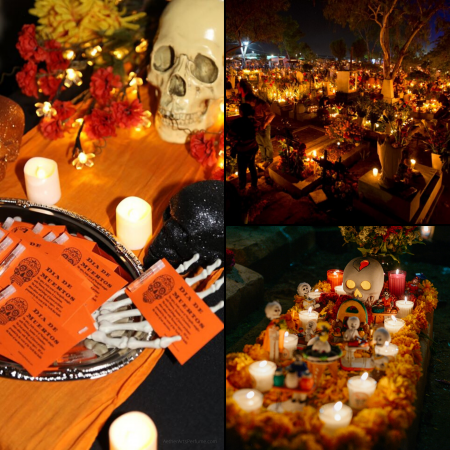
Dia collage by Amber Jobin©
Mexico’s Day of the Dead (Dia de los Muertos) is an observance both personal and communal – and as such, is observed quite differently from town to town. Certain symbols and elements are reprised in ritual overall, but the specifics may vary. As Sir James Frazer (of Golden Bough fame) astutely noted in his early attempt to better understand important rituals over time, if a culture can incorporate existing observances into a newly-adopted faith system, it is more likely that the newer beliefs will be accepted and adhered to with diminished resistance. With the Spanish conquest of Mexico we see the interweaving of pre-Christian belief/practice and the religion they carried with them like an heraldic banner.
“Kissing a girl behind the tomb on the Day of the Dead, her hair fragrant with all the flower petals boys have showered on her. We were thirteen, fourteen, something was beginning beyond kites that we believed we could hold onto longer…” ~ Ian Gonzales, Day of the Dead
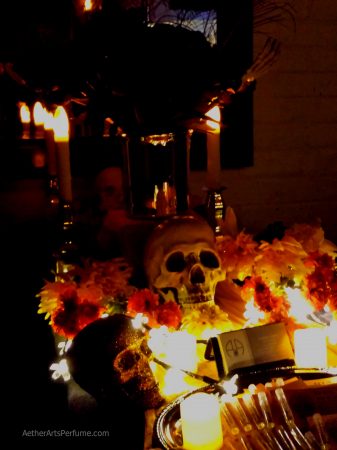
Altar de Dia de los Muertos via Amber Jobin
Symbols matter; their potency infiltrates the subconscious. They assume a life of their own. Some of the characters which populate Dia de Muertos figure prominently in most celebrations. Mexican poet Octavio Paz theorized that the holiday was promoted nationally as a way of continuing ancient Aztec celebrations of the dead. During these days, altars are constructed in the home (known as ofrendas). Sugar and chocolate skulls (calaveras) are displayed, as well as foods, beverages beloved by the deceased. If one is remembering a child, toys are placed upon the altar for “los angelitos”. Family graves are attended to with loving care and decorated; even pillows and coverlets are left there, so that the returned may rest after their long journey.
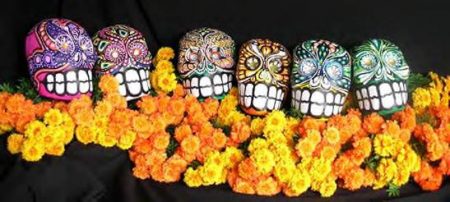
Getty images©
Aztec marigolds are both worn and decorate ofrendas and gravesites, as they are believed to entice the dead with their vibrant hues and aroma and help them find their way home once more. In Aztec times, the traditional drink was a potent fermented agave sap known as pulque; today people imbibe whatever was the departed’s favorite. Tamales are among the foods eaten and offered; pan de muerto is another, a sweet roll decorated with bits of pastry in order to mimic bones. Poems (calaveras literarias) are written and recited; they may be irreverent (making fun of the dead – their hypocrisy, malfeasance, bad temper, etc.) – or reflect upon how the living miss them (and vice versa). No topic is taboo…
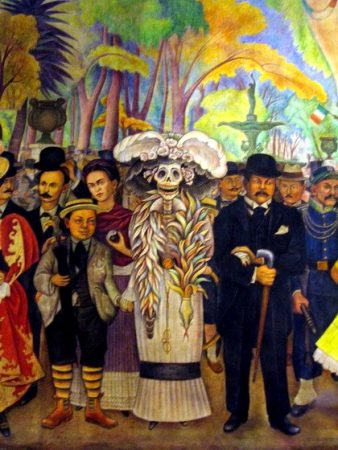
Diego Rivera mural Sueño de una tarde dominical en la Alameda Central, 1947 via Wikipedia.
The figure of La Calavera Catrina (The Elegant Skull) is emblematic of Dia de los Muertos; she was created by illustrator José Guadalupe Posada, a friend and contemporary of Diego Rivera and Frida Kahlo. La Catrina mocks the upper class Mexican woman’s desire to emulate the European female rather than embrace her indigenous roots. One can find her image everywhere, wearing a floppy hat, feathers, etc. The rescued mural of Diego Rivera entitled Sueño de una tarde dominical en la Alameda Central (Dream of a Sunday afternoon in Alameda Central), 1947 depicts Diego as a young boy hand in hand with La Catrina, who is bookended by Posada on the other side. Frida stands behind him; the content is rife with political reference since it skewers social complacency and bourgeois values prior to the 1910 Mexican Revolution.
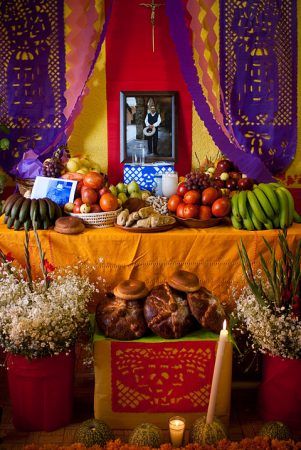
Altar de Dia de Muertos via wikipedia
Dia de Muertos opens on a quirky, tangy fruit note redolent of guava; there’s nothing sickly or cloying about it – it’s playful, frisky and imparts a tongue-in-cheek mood which is very much in keeping with this holiday. Combined with marigold, it glows with sun-infusion augmented by mimosa and jasmine. Carnation is present, and muted: the spiciness we come to expect feels bound up with the other accords. They in turn smell jungle-y and moist, an aromatic amalgam of juice and verdancy sprinkled with floral overtones. Beeswax smolders in the base, evoking the myriad lit tapers which radiate from every shrine and resting place as long as observance lasts – over two days’ time. I find it lyrical and unique, very evocative.
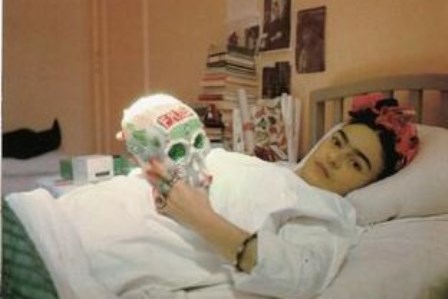
Frida Kahlo with a painted skull, about 1950, Photographer unknown.
Unlike several other compositions of Amber’s, Dia de Muertos is comprised of a ratio of 60% natural materials to 40% synthetics, with beeswax as the only true animalic. The chosen format is oil perfume in 35% concentration and tends to lie close to the skin, soft-spoken and haunting. It makes me want to break into song (which I did, when recounting it to my husband):
“Es blüht und duftet heut auf jedem Grabe,
Ein Tag im Jahr ist ja den Toten frei!
Komm am mein Herz, daß ich dich wieder habe
Wie einst im Mai!” ~ Allerseelen (All Souls’ Day) by Hermann von Gilm (favorite setting by R.Strauss)
“Each grave blooms and is fragrant; One day a year is given up to the dead.
Come to my heart, that I may have you again
As once in May!” (my translation)
Notes: tropical fruits and spices accord (includes guava, orange, tomato leaf, davana, spices) tropical flowers and foliage accord (including mimosa, jasmine, carnation absolutes),tropical woods and mosses (including moss, vetiver, Texas cedar) and beeswax
Sample kindly provided by the perfumer – many thanks, Amber! My nose is my own…
~ Ida Meister, Senior and Natural Perfumery Editor
(Dia de Muertos or Dia de Los Muertos both are correct translations)
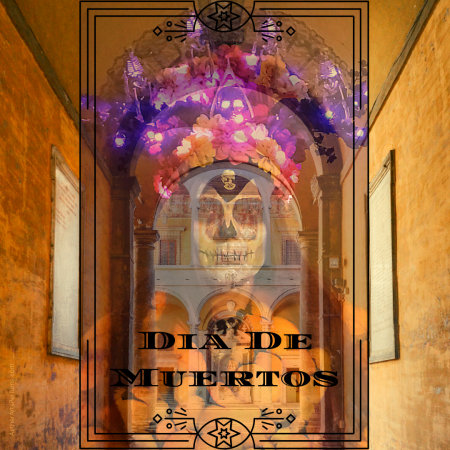
Aether Arts Dia de Muertos via Amber Jobin
Thanks to the generosity of Amber Jobin and we have a 5.5ml perfume ($58) of Aether Arts Perfume Dia de Muertos for one registered reader anywhere in the world. To be eligible, please leave a comment saying what appeals to you about Ida’s review (as well as historical background if it is new to you ) of Aether Arts Perfumes Dia De Muerto and where you live. Draw closes 10/31/2020
Follow us on Instagram @cafleurebon @idameister @aetherartsperfume
This is our Privacy and Draw Rules Policy
We announce the winners only on our site and on our Facebook page, so like Çafleurebon and use our blog feed… or your dream prize will be just spilled perfume.
